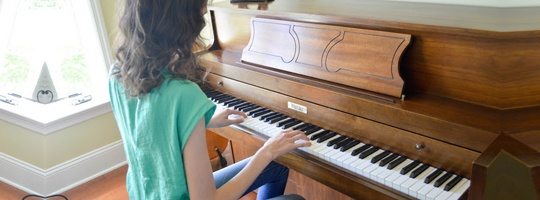
Most people affected by Marfan syndrome experience a life-changing moment when they or a loved one is first diagnosed. My Marfan journey, however, has always seemed a part of my life with no clear beginning. My mother was the first person in our family to be diagnosed with Marfan syndrome. It had been my grandmother’s just-by-chance reading of a newspaper article about the disorder that led to my mother’s diagnosis at age 7. Fortunately, when I was a very young child, my doctors knew to look for the physical characteristics right away and, when I was about 3 years old, it was determined that I too had Marfan syndrome. When I started elementary school, of course there were little issues here and there, such as being taller and thinner than most kids, sitting out for certain activities during gym class, and taking annual trips to Johns Hopkins Hospital for checkups. For the most part, however, I thought of Marfan syndrome as no big deal. It was something I had, like hazel eyes and brown hair.
It wasn’t until a few years ago that I truly felt the impact of having Marfan syndrome. I always had a small degree of scoliosis, but as I grew even taller, the curves began to grow larger. My orthopedist, Dr. Sponseller, at Johns Hopkins Hospital, recommended a brace. I spent almost a year in a hard, plastic brace, and, for the first time, I thought of Marfan syndrome as taking a toll on me. Ultimately, the brace did not improve my spine and surgery was the only way to correct the scoliosis that was nearly 90 degrees. After getting a second opinion and discussing it with my parents, I decided to have the surgery. Last summer, I underwent spinal fusion surgery, which involved putting two titanium rods on either side of my spine. The operation was scary, and I did not look forward to the many weeks of recuperation. When the day came to go to the hospital, I was nervous but also hopeful that the surgery would increase my quality of life exponentially. Two days after surgery I was able to get out of bed, and I vividly remember walking to the mirror and immediately turning to my side to look at my shoulder blades. I was overjoyed to notice that they were not only even, but also that I was standing straight and tall.
It has been more than a year since my spinal fusion surgery, and I have no scoliosis and no back pain. Before the surgery, it was difficult to play cello and piano because after a short time my back would start to ache. Now I have no trouble playing my instruments. I am active, healthy, and grateful to have such a successful outcome of my surgery. I feel confident in my appearance and my ability to handle life’s difficult situations. Although Marfan syndrome will present me with challenges, I am extremely grateful that there are medical advancements and research available today that enable people with Marfan syndrome to live longer and more fulfilling lives.
When I was going through these stressful years, I wished I would have had another teen to guide and encourage me. I want other teens to know that they can live a wonderful life with Marfan syndrome, if they just stay positive. Although Marfan syndrome affects us all in unique ways, there is still a common theme in all our stories.
I would like to spread a positive message about living life to the fullest by sharing your stories of accomplishment, dreams, and exciting experiences. I plan on doing this by creating a book entitled “Stories from the Heart,” which will be a compilation of uplifting, joyful, and encouraging stories from teens living with Marfan syndrome. It is my sincere hope that young people in the Marfan and related disorders community will read this book and understand that they are not alone.
If you have an uplifting story that you would be interested in having published in the book, please submit it for consideration to soschuetze@gmail.com. Stories should be 200-500 words and be submitted by December 31, 2016.

Sinclaire Schuetze is a 15-year-old sophomore at Hempfield High School in Lancaster, PA. She plays piano and cello and dances with the Lancaster Liederkranz German folk dancing Kindergruppe. She is the editor of her school newspaper and is active in the Anchor Club and Key Club, which are community service clubs in her school.
